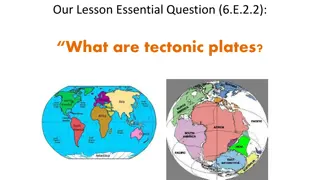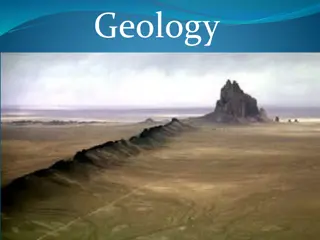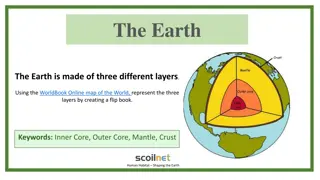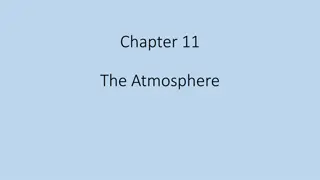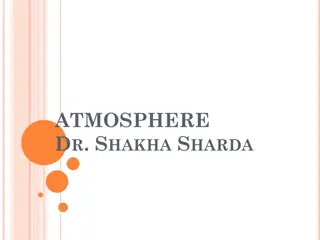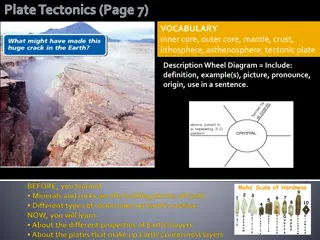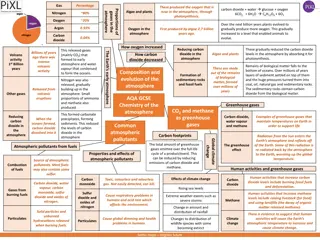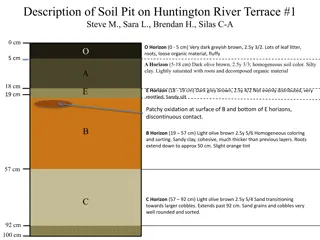Exploring Layers of Earth's Atmosphere
Earth's atmosphere consists of five major layers, each with unique properties and temperature changes with altitude. The troposphere, closest to the Earth's surface, experiences a temperature decrease with altitude due to heat from the sun and Earth's surface. Learn about the properties of the troposphere and how air mixing and temperature inversions impact atmospheric conditions.
Download Presentation

Please find below an Image/Link to download the presentation.
The content on the website is provided AS IS for your information and personal use only. It may not be sold, licensed, or shared on other websites without obtaining consent from the author. Download presentation by click this link. If you encounter any issues during the download, it is possible that the publisher has removed the file from their server.
E N D
Presentation Transcript
Lesson Objectives Describe how the temperature of the atmosphere changes with altitude. Outline the properties of the troposphere. Explain the role of the ozone layer in the stratosphere. Describe conditions in the mesosphere. Explain how the sun affects the thermosphere. Identify the exosphere.
Vocabulary exosphere mesosphere ozone stratosphere temperature inversion thermosphere troposphere
Introduction Earth s atmosphere is divided into five major layers. The layers are based on temperature. Temperature of the Atmosphere Air temperature changes as altitude increases. In some layers of the atmosphere, the temperature decreases. In other layers, it increases. You can see this in Figurebelow. Refer to this figure as you read about the layers below.
How does air temperature change in the layer closest to Earth?
Troposphere The troposphere is the lowest layer of the atmosphere. In it, temperature decreases with altitude. The troposphere gets some of its heat directly from the sun. Most, however, comes from Earth's surface. The surface is heated by the sun and some of that heat radiates back into the air. This makes the temperature higher near the surface than at higher altitudes.
Properties of the Troposphere Look at the troposphere in Figure above. This is the shortest layer of the atmosphere. It rises to only about 12 kilometers (7 miles) above the surface. Even so, this layer holds 75 percent of all the gas molecules in the atmosphere. That s because the air is densest in this layer.
Mixing of Air Air in the troposphere is warmer closer to Earth s surface. Warm air is less dense than cool air, so it rises higher in the troposphere. This starts a convection cell. Convection mixes the air in the troposphere. Rising air is also a main cause of weather. All of Earth s weather takes place in the troposphere.
Temperature Inversion Sometimes air doesn t mix in the troposphere. This happens when air is cooler close to the ground than it is above. The cool air is dense, so it stays near the ground. This is called a temperature inversion. An inversion can trap air pollution near the surface. Temperature inversions are more common in the winter. Can you explain why?
Tropopause At the top of the troposphere is a thin layer of air called the tropopause. You can see it in Figure above. This layer acts as a barrier. It prevents cool air in the troposphere from mixing with warm air in the stratosphere.
Stratosphere The stratosphere is the layer above the troposphere. The layer rises to about 50 kilometers (31 miles) above the surface. Temperature in the Stratosphere Air temperature in the stratosphere layer increases with altitude. Why? The stratosphere gets most of its heat from the sun. Therefore, it s warmer closer to the sun. The air at the bottom of the stratosphere is cold. The cold air is dense, so it doesn t rise. As a result, there is little mixing of air in this layer.
The Ozone Layer The stratosphere contains a layer of ozone gas. Ozone consists of three oxygen atoms (O3). The ozone layer absorbs high-energy UV radiation. As you can see inFigure below, UV radiation splits the ozone molecule. The split creates an oxygen molecule (O2) and an oxygen atom (O). This split releases heat that warms the stratosphere. By absorbing UV radiation, ozone also protects Earth s surface. UV radiation would harm living things without the ozone layer.
Stratopause At the top of the stratosphere is a thin layer called the stratopause. It acts as a boundary between the stratosphere and the mesosphere.
Mesosphere The mesosphere is the layer above the stratosphere. It rises to about 85 kilometers (53 miles) above the surface. Temperature decreases with altitude in this layer.
Temperature in the Mesosphere There are very few gas molecules in the mesosphere. This means that there is little matter to absorb the sun s rays and heat the air. Most of the heat that enters the mesosphere comes from the stratosphere below. That s why the mesosphere is warmest at the bottom.
Meteors in the Mesosphere Did you ever see a meteor shower, like the one in Figure below? Meteors burn as they fall through the mesosphere. The space rocks experience friction with the gas molecules. The friction makes the meteors get very hot. Many meteors burn up completely in the mesosphere. Friction with gas molecules causes meteors to burn up in the mesosphere.
Mesopause At the top of the mesosphere is the mesopause. Temperatures here are colder than anywhere else in the atmosphere. They are as low as -100 C (-212 F)! Nowhere on Earth s surface is that cold
Thermosphere The thermosphere is the layer above the mesosphere. It rises to 600 kilometers (372 miles) above the surface. The International Space Station orbits Earth in this layer as in Figure below.
Temperature in the Thermosphere Temperature increases with altitude in the thermosphere. Surprisingly, it may be higher than 1000 C (1800 F) near the top of this layer! The sun s energy there is very strong. The molecules absorb the sun's energy and are heated up. But there are so very few gas molecules, that the air still feels very cold. Molecules in the thermosphere gain or lose electrons. They then become charged particles called ions.
Northern and Southern Lights Have you ever seen a brilliant light show in the night sky? Sometimes the ions in the thermosphere glow at night. Storms on the sun energize the ions and make them light up. In the Northern Hemisphere, the lights are called the northern lights, or aurora borealis. In the Southern Hemisphere, they are called southern lights, or aurora australis.
Glowing ions in the thermosphere light up the night sky.
Exosphere The exosphere is the layer above the thermosphere. This is the top of the atmosphere. The exosphere has no real upper limit; it just gradually merges with outer space. Gas molecules are very far apart in this layer, but they are really hot. Earth s gravity is so weak in the exosphere that gas molecules sometimes just float off into space.
Lesson Summary Earth s atmosphere is divided into five major layers. The layers are based on temperature. The troposphere is the lowest layer. Temperature decreases with altitude in this layer. All weather takes place here. The stratosphere is the layer above the troposphere. Temperature increases with altitude in this layer. The ozone layer occurs here. The mesosphere is the layer above the stratosphere. Temperature decreases with altitude in this layer. Meteors burn up here. The thermosphere is the layer above the mesosphere. Temperature increases with altitude in this layer. The northern and southern lights occur here. The exosphere is the highest layer. Air molecules are very far apart. They may escape Earth s gravity and float into space.
Lesson Review Questions Recall 1. How does temperature change in the troposphere? 2. What is a temperature inversion? 3. Why is the ozone layer in the stratosphere important to life on Earth? 4. Where does the mesosphere get its heat? Apply Concepts 5. Think of a creative way you could model the layers of the atmosphere. Describe your model. How does it show temperature differences between the layers? Think Critically 6. How is a temperature inversion like the temperatures of the stratosphere and troposphere? 7. Explain why air mixes in the troposphere but not in the stratosphere. 8. Why is there a hole in the ozone layer? What do you think the consequences of that hole are? Points to Consider Energy from the sun is responsible for winds that blow in the troposphere. What is wind? How does energy cause winds to blow?







